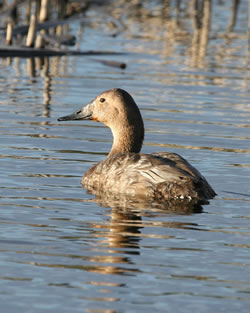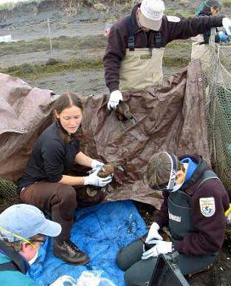Information for Hunters, Bird Watchers, and Backyard Naturalists About Highly Pathogenic Avian Influenza
What is it?
Avian influenza, or "bird flu" is a disease caused by a virus that infects birds, including pets, domestic poultry, and wild birds. The highly pathogenic H5N1 strain of avian influenza has on rare occasion infected humans, typically through extensive contact with infected poultry, with serious consequences when infection does occur. The World Health Organization compiles statistics on the number of human cases of the disease since it first appeared in 1997. The World Organization for Animal Health maintains statistics on H5N1 avian influenza in animals.
Is it in North America?
As of September, 2007, we have no evidence that this strain of bird flu is present in North America in either wild or domestic birds. However, the potential exists for wild migratory birds to carry the virus to North America, or for the virus to be introduced through the legal wild bird pet trade, shipment of goods from overseas, smuggling, or other means. The Service and other agencies of the U.S. government are taking steps to minimize the potential impact of the occurrence of this disease should it occur within the United States.
How can I protect myself?
While experts believe there is currently very little risk to people in the United States, it is always wise to practice good hygiene when handling or cleaning wild birds or poultry. Here are some specific practices to follow:
Clean completely
If you have come in contact with wild birds, do not rub your eyes, eat, drink, or smoke before you wash. Wash your hands thoroughly in soap and water or alcohol-based hand products. Flu viruses are also inactivated with many common disinfectants such as detergents, 10 percent household bleach, and alcohol. The USGS National Wildlife Health Center offers cleaning recommendations.
Cook thoroughly
Cook all meat, including wild birds and poultry, thoroughly (155 to 165 degrees Fahrenheit, 64 to 74 Celsius) to kill disease organisms and parasites. Avoid raw or partially cooked (runny) eggs.The Department of Agriculture has some tips on safe food handling.
Handle with care
Hunters should always follow common-sense sanitary practices when handling, cleaning, and preparing wild birds, as described above. Be sure to sanitize knives, other cleaning tools, and food preparation surfaces.
Admire from a distance
As a general rule, you should observe wildlife, including wild birds, from a distance. This protects you from possible exposure to viruses and minimizes the disturbance to the animal. Wear disposable gloves when cleaning or handling backyard feeders, bird baths or other equipment.
Inform authorities
If you find a sick or dead animal, contact your state, county, tribal, or local natural resources agency
Stay informed
While the HP5N1 avian influenza strain has not been found in North America, many migratory bird species spend time in areas of the world where the flu is active. At right is a list of several Web sites and fact sheets providing updated information and advice (PDF) regarding the H5N1 avian flu virus. The Federal government offers one-stop access to the most current avian influenza information at pandemicflu.gov.
What is the Service doing?
The Fish and Wildlife Service is working with other Federal and state agencies to enact a strategic plan (PDF) announced March 20, 2006 by the Departments of Agriculture, Interior, and Health and Human Services to monitor bird populations for the earliest possible detection of the H5N1 virus if it enters this country. The plan contains five major strategies:
- Testing wild birds that have died or are sick offers the highest and earliest probability of detecting the H5N1 strain should it be introduced into this country by migratory birds. This strategy expands existing programs to investigate disease outbreaks.
- Sample testing of live wild birds will target those species that represent the highest risk of being exposed to, or infected with, the H5N1influenza strain because of their migration patterns. Many populations of migratory birds that nest in Alaska spend winter in parts of Asia where the virus is endemic.
- Sample testing of hunter-killed birds at check stations operated by the Service and state natural resource agencies supplements the samples from live wild birds.
- Monitoring and testing of sentinel animals such as duck flocks that can be placed in wetland areas where they will commingle with wild birds. The ducks are then monitored and tested for the virus.
- Environmental sampling monitors water and/or fecal samples from waterfowl habitat.
This information and more has been compiled in a downloadable PDF fact sheet.
Strategic plan fact sheet
Entire strategic plan
Monitoring and preventative measures
 |
Visit PandemicFlu.gov for one-stop access to U.S. Government avian and pandemic flu information. |
|
|


